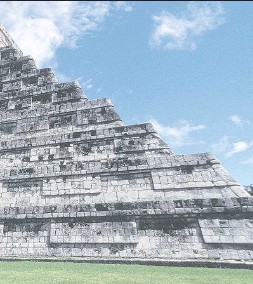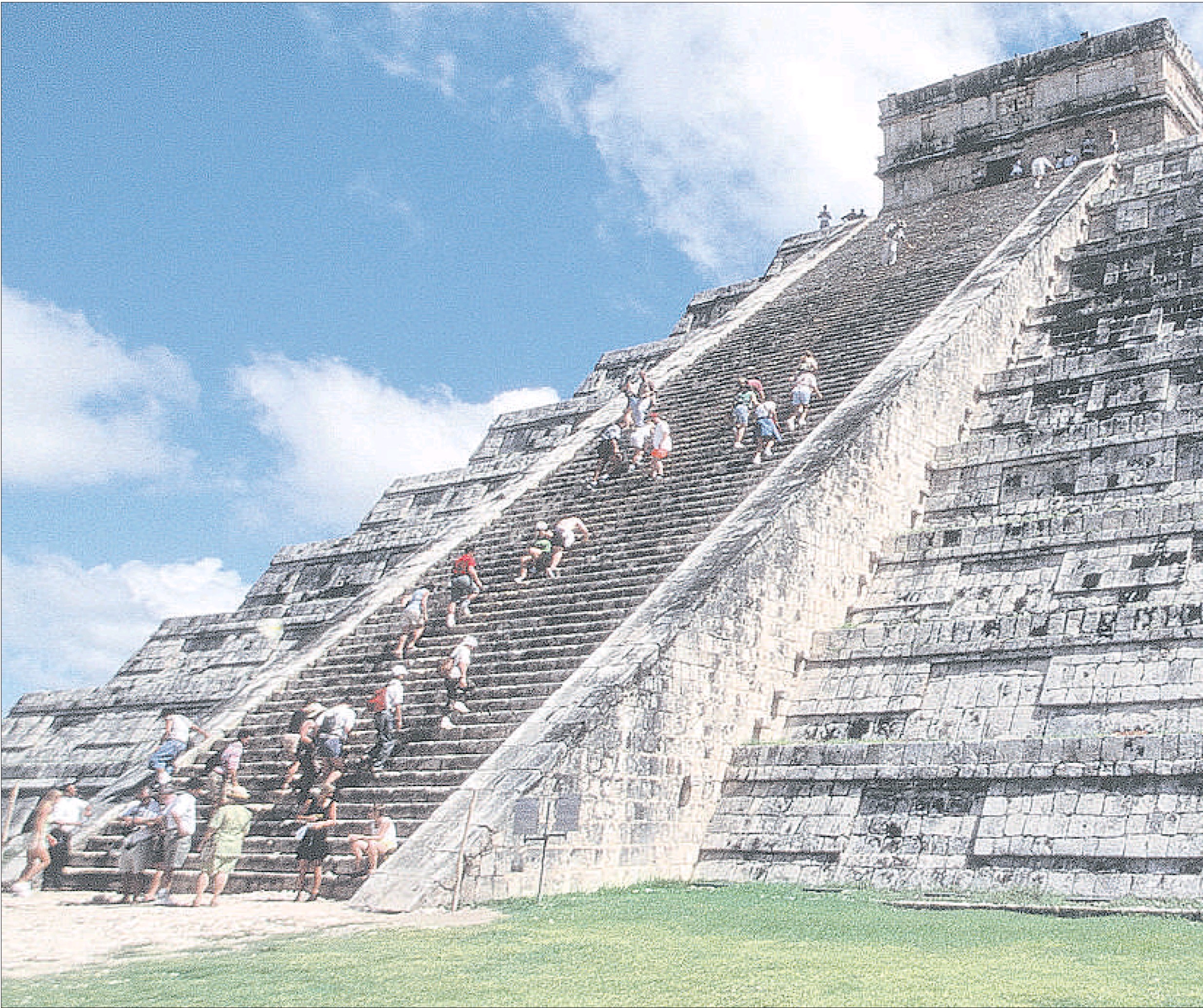The two Cancuns provide a taste of the Mayans’ ancient playground
Gary May
Sun


The main pyramid at Chichen Itza, Mexico, El castillo has 91 steps on each of its four sides. The Pyramid was built on top of a smaller pyramid.

The waters around Cancun are among the best in the world for snorkelling.
When the Mayans erected their majestic stone cities 1,000 years or so ago, they typically built in the tropical rainforests of Mexico and Central America. Tulum was unique among those cities — the only one that was walled and the only one facing the water.
It’s a fanciful but not entirely unlikely thought that like today’s travellers, the ancients delighted in the region’s shimmering turquoise Caribbean waters, endless beaches and blazing sunshine. Yet its isolation kept Cancun, just north of Tulum, out of the tourist spotlight until the 1970s. Since then, Cancun has grown from a slumbering fishing village into Mexico’s showcase tourist paradise, a destination so varied in its appeal that it offers something for just about anyone’s tastes.
Today there are two Cancuns: the city of half a million built around the downtown El Centro, and the hotel zone, a strip of shining towers that resembles Miami Beach, hugging a spit of land featuring sandy beaches facing the ocean and a palm-laced lagoon to its back.
Second World War American servicemen discovered the area’s splendid opportunities for diving and snorkelling while they were stationed on Cozumel, just off the coast from Cancun. Jacques Cousteau paid a visit in 1959 and declared it a diver’s dream. That, in combination with planning for the 1968 Olympics in Mexico City, set the Mexican government to thinking. The concept of a mega-resort zone was hatched, and the first upscale hotels built on the beach strip in the 1970s.
Today, the opportunities for adventure — for those who want more than rest and relaxation on the beaches — are endless: you can try parasailing, diving, golf, tennis and deep-sea fishing. Nearby are Mayan archeological sites, little villages where you can find a quiet guest house, B&B and cantina. You can swim with the dolphins and snorkel around offshore reefs or in the world’s largest natural aquarium. Most hotels offer excursions to area attractions and points of interest.
Indoors, entertainment ranges from discos to quiet piano bars, and there are world-class restaurants serving an array of international cuisine and authentic Mexican fare. There’s shopping for all tastes and budgets, with high-end shops stocking designer labels.
Cancun offers more than 150 hotels and more than 25,000 rooms. The most coveted are those from which you can walk out onto your Caribbean-facing balcony and take in the warm sea breezes. Accommodation along the beach-facing hotel zone is generally more expensive than the more modest hotels and guest houses in El Centro. The zone, or strip, offers everything from villas and self-catering condos to five-star hotels, resorts and spas.
While the strip provides a broad range of shopping, the best places to find locally produced handicrafts and art pieces can be found in El Centro.
El Centro is easily and inexpensively reached by public transit or taxi. It has its modern facade, but interspersed there are generous pockets of authentic Mexican culture, entertainment, shopping and accommodation.
The two Cancuns represent separate worlds. Take the food, for instance, served in the area’s 500 restaurants. The hotel strip has ample fine dining establishments as well as family-friendly buffets that let the kids fill up on hot dogs and fries while Mom and Dad indulge in more daring fare. But if you stick only to the hotel strip, you’ll miss the tasty, authentic and economically priced local dishes available in El Centro.
Yucatecan food features plenty of fresh fish, marinated meats and poultry. It liberally employs limes and oranges with unique herbs to bring out all the best in the ingredients. Exciting entrees can be had for well under $10 US. Just hop on a bus that links the hotel strip to El Centro and begin to explore for the treats — and after-dinner entertainment — that await you.
Despite its allure, Cancun has come through challenging times of late. In 2005, Hurricane Wilma wiped out much of the resort’s beaches and severely damaged hotels. The country’s drug-related violence gave some tourists cause to reconsider a visit and earlier this year, Cancun’s police chief was arrested in connection with the torture-murder of a government anti-drug fighter. More recently, several airlines suspended flights because of the swine flu and this summer a hotel was accused of stealing sand to bulk up its beaches, still suffering from the loss of sand in the 2005 hurricane. But reconstruction of the Wilma-damaged hotels is complete, the government is replacing the beaches along the 30-kilometre hotel strip in an environmentally friendly fashion and, in a sign of its confidence in the future, a second airport at Tulum is planned. And while advisories are occasionally released in connection with Mexico’s drug-related violence, tourists are merely urged to take care in choosing their surroundings.
History buffs will want to take a tour to one of the nearby archeological zones such as the ocean-side Tulum, or the sprawling, jungle-bound Chichen Itza, a three-hour trip through the rainforest where you can climb the great pyramid and get a lesson in the highly developed Mayan culture. You’ll hear that after the rainforest cities were abandoned, the vegetation grew so thickly that those who rediscovered the huge stone structures literally ran into them before understanding what they had found.
Along the way, visits to the colonial cities of Valladolid and Merida are well worth the effort. Colourfully dressed Mayan women sell their crafts in Valladolid’s Plaza. Buildings in Merida were constructed from stone taken from earlier Mayan cities. Tours can be arranged from your hotel but if you’re a do-it-yourselfer, staff will help you rent a car.
Cancun offers an abundance of nearby snorkelling venues. Xel-Ha is a salt-water lagoon and the world’s largest natural aquarium, teeming with thousands of multi-coloured tropical fish. There, you can also swim with the dolphins. Offshore are Isla Mujeres and Cozumel, where you can snorkel or scuba dive along coral reefs.
If you’re looking for Cancun’s quieter side, head down the coast to the Riviera Maya where there are still world-class resorts, but fewer of them, and the pace is dialed back a notch. If you want to experience a more Zen-like existence, there’s the modern town of Tulum, where resorts are often off the grid and the architecture might be described as upscale Gilligan’s Island.
Or perhaps you’d like to slip back in time, to catch a glimpse of what Cancun was like before it was transformed into a holiday retreat. If so, head 30 kilometres south to Puerto Morelos, which offers hotels, guest houses and B&Bs in a quiet community of about 5,000.
– – –
BEFORE YOU GO, IT’S GOOD TO KNOW ABOUT
– Weather. Cancun boasts a subtropical climate, with average daytime temperatures ranging from 27 C to 35 C and the landscape bathed in sunshine more than 240 days of the year. It rains more from May to October and there are occasional visits by hurricanes in September and October. Regular offshore breezes make temperatures at the resort more moderate than in the nearby tropical forest, which can be extremely hot and humid, even during January to March.
– Food and water. The purified water available from hotel taps is perfectly safe. It’s advisable to drink only bottled water while exploring beyond your hotel. In the markets and while buying from street vendors, peel all fruits and vegetables and avoid lettuce. Go slow on the Mexican spices and style of cooking if you’re not familiar with it.
– Clothing. Bathing suits should only be worn at the beach and pool. Dress is casual resort wear — jackets and ties are rarely needed. But if you’re headed to the disco, it’s customary to dress up. Most nice restaurants and bars require men to wear slacks, although some allow Bermuda shorts.
– Medical care. Mexico has a nationalized health care system. In Cancun, medical care is close at hand and most hotels have a doctor on call 24 hours a day. No vaccinations are needed to enter Mexico.
– Shopping. El Centro offers plenty of authentic Mexican shopping. Expensive perfume can be purchased for one-third of what it costs in Canada. The hotel strip offers a glitzier, more expensive brand of shopping with plenty of designer labels available.
– Gambling. The only legal gambling in Mexico is sports betting. There are no legal casinos although some resorts hold casino nights in which participants play for prizes.
– Winter break. Families and empty nester couples should be aware that students from Canada and the U.S. flood into Cancun during their winter break weeks, just as they do in Florida, turning the strip into party central.
– On arrival. From the airport, you can take a shared shuttle or private service van or car to hotels. For information call 1-800-317-1921 or e-mail [email protected].
Website: www.cancun-airport.com/transportation.htm
FACTBOX: DID YOU KNOW
– The Yucatan Peninsula was originally inhabited by the Mayans, who were expert mathematicians and astronomers and enjoyed a detailed understanding of the stars and the rotation of the sun. By the time the Spaniards arrived in 1519, their great cities, such as Chichen Itza, had already been abandoned.
– Cancun was identified in the late 1960s as a place well situated for development as a world-class resort. The first exclusive hotels were built in the 1970s, when Cancun was a small fishing village. Today the city has a population of about 580,000.
– Cancun was once called Ekab, or “black earth.” Cancun means “pot of snakes” in the Mayan language.
© Copyright (c) The Vancouver Sun
